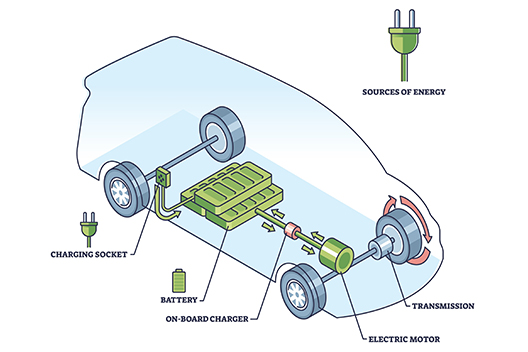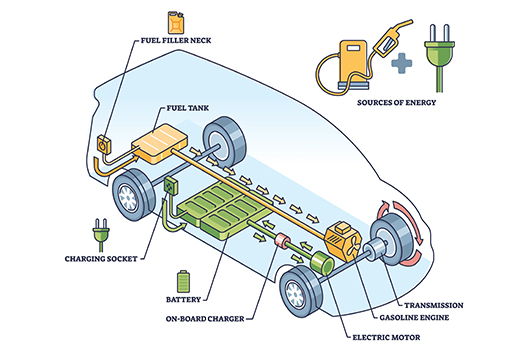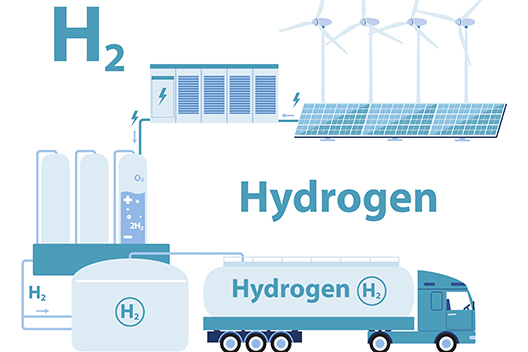Why Drive Electric
- ON THIS PAGE:
- Types of Zero Emmission Vehicles
- Benefits
- FAQs
The Future of Transportation
Electric vehicles (EVs) are the future of transportation. You can find quiet, emissions-free EVs in many different makes and models that fit your lifestyle and driving habits. EVs offer more convenience with the ability to charge at home and work. EVs also have a lower total cost of ownership compared to internal combustion engine (ICE) vehicles, thanks to savings on fuel and fewer maintenance needs.
How Do EVs Work?
Instead of combustion engines, EVs have large, dense battery packs which power an electric motor. No combustion engine means EVs have no tailpipes or tailpipe emissions, which is a major benefit for public health and the climate. EVs also feature regenerative brakes, which allow energy to be recaptured and stored during the braking process.
Types of Zero Emission Vehicles

Battery Electric Vehicle (BEV)
Fully electric vehicles have a battery-powered motor and zero tailpipe emissions.

Plug-in Hybrid Electric Vehicle (PHEV)
Plug-in hybrid vehicles use a combination of battery power and gasoline engine. Some models can drive in full electric mode with gasoline used to extend the vehicle’s range.

Hydrogen Vehicle
Hydrogen fuel cells are created through electrolysis, which can be powered by 100% clean energy.

Electric Bikes and Scooters
E-bikes and scooters have an electric motor that does some of the work for you.
Benefits
-
Save Money on Fuel A Montgomery County resident who drives 12,000 miles a year and charges at home would spend approximately $40 per month on electricity.
-
Easier to Maintain Electric motors have 1% of the moving parts of an internal combustion engine — that means there is less to break down.
-
Tax Incentives By purchasing an electric vehicle, you’ll qualify for a federal tax credit up to $7,500 depending on brand of vehicle.
-
Cleaner Environment An all-electric vehicle produces 0 tailpipe emissions where it operates, meaning cleaner air in the places we work and live. In Maryland’s utility grid, BEVs emit less than 1/3 of the CO2e per mile than a new gasoline vehicle.
Frequently Asked Questions
Find
Number of results:
How can I save money buying an EV?
Auto manufacturers offer a wide range of EV models for different price points that are comparable to gasoline vehicles. Buying any vehicle is a big investment, but certain EV models are eligible for federal tax credits of up to $7,500 for new vehicles and $4,000 for used vehicles if purchased before September 30, 2025. Ask your dealership if they include the value of the tax credit in your lease or purchase price. Beginning July 1, 2023, the State of Maryland provides an excise tax credit of $3,000 on certain models. Discounts and promotions may also be available from Electrified Dealers as part of the EV Purchasing Co-op. Visit the EV Incentives page to find more information on incentives.
Are used EVs a good investment?
A pre-owned (used) battery-electric or plug-hybrid vehicle is a great option to replace an old gas-guzzler. Pre-owned EVs will typically have fewer miles on the odometer than a pre-owned ICE vehicle. When shopping for a pre-owned EV, ask the dealer for a detailed report on the battery health or if the battery was replaced by the previous owner. Also ask about whether the original battery is still under warranty and whether it is transferrable.
How much does it cost to charge an EV?
A Maryland resident who drives an average of 12,000 miles per year (30-40 miles per day) will pay approximately $40 per month for electricity to power their EV, saving up to $7,000 in fuel costs over a five-year period compared to average new gasoline vehicles. Use this tool from Pepco to calculate fuel costs and compare different models.
In addition, EVs have fewer moving parts and lower maintenance costs. On average, EV owners save up to 50 percent on vehicle maintenance compared to ICE vehicles.
Where do I charge in public?
There are over 500 charging stations open to the public in Montgomery County, with more are being added by local businesses, the County, the State of Maryland, and local utilities. You can find charging in parking garages, shopping centers, and parks. Check the Department of Energy Alternative Fuels Data Center or charging station location services such as Plugshare to find an EV charger near you.
How far can I go on one charge?
There are many EVs available with ranges of 250 miles or more. The total range of your battery will be impacted by your driving and charging habits and the temperature outside. If you regularly commute long distances or need more flexibility, plug-in hybrid vehicles offer electric range for around-town commuting with gasoline backup for longer trips.
What happens if I run out of battery?
EVs have a variety of features that help you plan ahead and avoid running out of battery. The dashboard clearly shows the amount of charge remaining and the number of miles you have left to travel. Many vehicles also estimate the amount of time it will take to re-charge using different types of charging equipment. When your battery gets very low, the vehicle will automatically enter a power saving mode that extends your range. Many EVs include a navigation feature that lets you search for nearby charging stations. If you intend to go on a long-range trip, plan your route in advance to stop somewhere you can charge along the way.
If you run out of charge, you will need to call a tow truck. Note that many EVs don’t have a neutral gear like gas-powered cars, so your EV will need to be towed on a flatbed truck to a charging location. Your EV battery will last longer and perform better if you do not regularly deplete the charge to zero.
Are EVs safe to drive and charge?
According to the Federal Emergency Management Administration (FEMA) and the Insurance Institute for Highway Safety (IIHS), EVs are safe to charge at your home or business when operated correctly with certified charging equipment. FEMA provides EV charging safety tips in this article.
Data compiled from the National Transportation Safety Board (NTSB), the Bureau of Transportation Statistics (BTS), and from Recalls.gov shows that electric vehicles are less likely to catch fire than gas-powered vehicles. When EV battery fires occur, they can require more resources to put out.
How can I maintain a healthy EV battery?
EV batteries can last 20 years or up to 300,000 miles. Some older EV models had challenges with battery recalls, but the EV battery replacement rate is very low for newer models. However, the way you charge the battery can affect its long-term health. To maximize the life and performance of your battery, keep the charge level between 20-80% as often as possible. Unless you’re taking a long-range trip, use automatic features to limit the total charge to 90% and avoid frequent use of DC fast charging, which places more strain on the battery.
How does weather affect battery performance?
It is safe to drive and charge the vehicle in wet conditions like rain and snow. Hot and cold weather has some impact on battery performance, but mainly because of increased use of climate control features. Using air conditioning might decrease your battery range between 15-20% and heating between 20-30%. If your car is outside in the hot sun, it will need work harder to cool down so use a windshield cover or park in the shade. On a cold day, drive a little to warm the battery up before using DC fast charging.
Do EVs really reduce emissions? What about the pollution from the power plant?
EVs have no tailpipe emissions, so pollution from EVs depends on the mix of sources that the local power grid uses to generate power. In Maryland, an all-electric vehicle will be responsible for only about 27% of the CO2 emissions of a gasoline-powered vehicle. The comparison will get even better as more renewable energy sources, like solar and wind, are added to the grid in the coming years. Even in places that rely heavily on coal power plants, EVs have lower emissions because an electric drive train is more efficient than an internal combustion engine. You can learn more about pollution from the Department of Energy’s Alternative Fuel Data Center and the Union of Concerned Scientists.